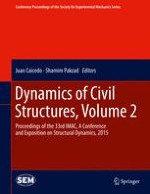Dynamics of Civil Structures, Volume 2. Proceedings of the 33rd IMAC, , A Conference and Exposition on Balancing Simulation and Testing, 2015, the second volume of ten from the Conference brings together contributions to this important area of research and engineering. The collection presents early findings and case studies on fundamental and applied aspects of Structural Dynamics, including papers on:
Modal Parameter Identification
Dynamic Testing of Civil Structures
Human Induced Vibrations of Civil Structures
Correlation & Updating
Operational Modal Analysis
Damage Detection of Structures
Bridge Structures
Damage Detection Models
Experimental Techniques for Civil Structures
